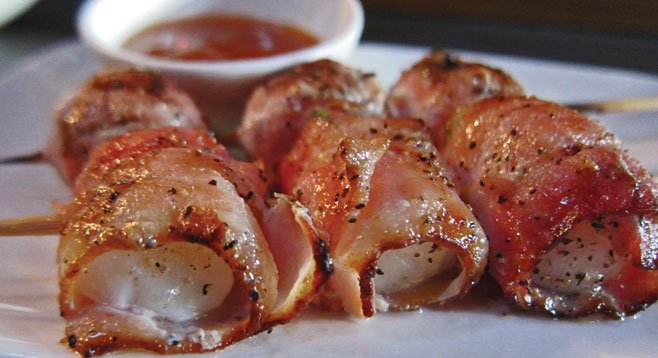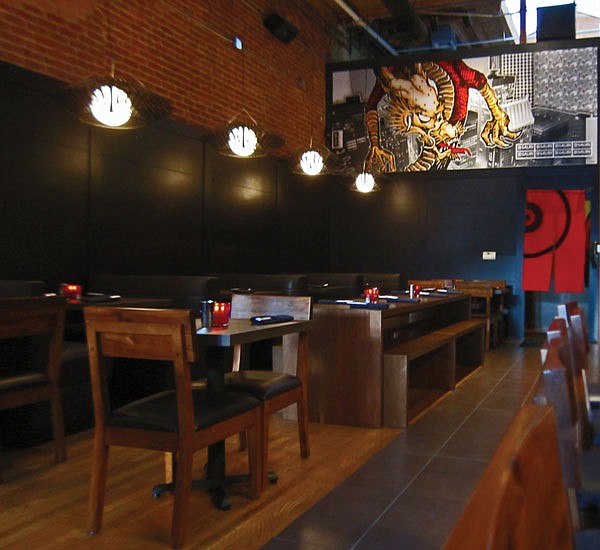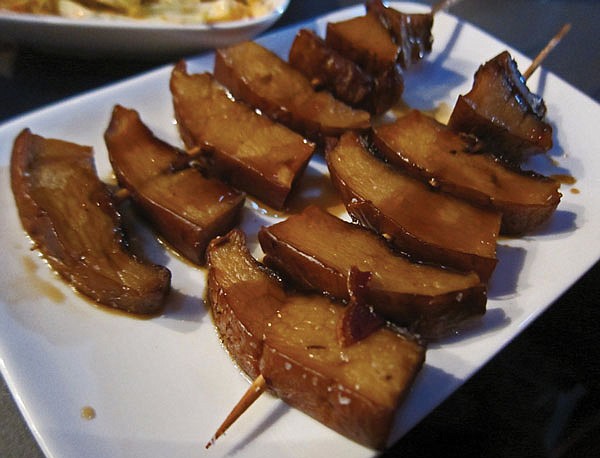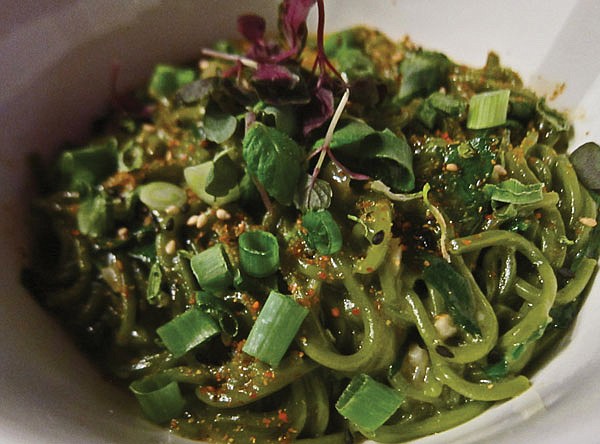 Facebook
Facebook
 X
X
 Instagram
Instagram
 TikTok
TikTok
 Youtube
Youtube

I wasn’t sure what to think when I first heard about Gaijin Noodle + Sake House. Taken literally, the word “gaijin” means “foreigner.” In actual usage, it means “non-Japanese.” But growing up in Hawaii, “gaijin,” like the word “haole,” was often used by my family and friends accompanied by unflattering and colorful adjectives.
That Gaijin was the project of Chef Antonio Friscia (formerly of Stingaree) and his partners West Group didn’t change my somewhat unfair impression that the place would be more style than substance. It wasn’t enough for me to drive down to the Gaslamp.
What it took to convince me was a good friend, Candice, whose taste buds and judgment I trust. She told me that Chef Friscia, a regular at the now-defunct Hillcrest location of Yakyudori, was serious about putting out a good product. Yakitori chef Komei Nishiyama's experience at Raku (Yakyudori’s replacement in Hillcrest) didn’t interest me as much as Komei-san’s six months at Yakyudori.

Gaijin is located in the spot the Cheese Shop used to occupy in the Gaslamp. The interior is full of dark tones and exudes a sleek, urban feel, but the vibe is relaxed and casual. What really got my attention was the rectangular grill behind a Plexiglas window. Gaijin uses binchotan, a low-smoke, oak-based charcoal that adds a distinctive smoky flavor. A simple chicken wing seasoned with sea salt and grilled over binchotan can taste magical.
You are provided with two menus. The first lists various noodles, entrées, appetizers, basic yakitori, and drinks. The second is a printed checklist of available yakitori items. Don’t forget to check the chalkboard next to the gong (sounded when free rounds of sake will be passed out). I once had a skewer of sweet scallops enrobed with wonderful Nueske’s bacon, which, without viewing the chalkboard, I would have missed.
Over three visits to Gaijin, I tasted a variety of robata (grilled) items, in addition to a couple of noodle dishes — after all, this is a “noodle house.” What I found is that the more traditional robatayaki items, such as skewered cubes of chicken thigh — called momo in Japanese — weren’t up to the level of Yakyudori on Convoy. Both times I ordered the dish here, there wasn’t enough salt and the pale chicken lacked caramelization, as if it hadn’t been grilled close enough to the charcoal on the brazier. An abundance of black pepper also detracted from the flavor; the skirt steak and beef tongue suffered similarly. The chicken meatball, or tsukune, had too much ginger in it for my taste, and the tare, a sweet, soy-based sauce used to flavor certain yakitori items, had burned.
And, yet, to put everything into perspective, my good friends Candice, Howie, and Jenne, along with yours truly, recently did a two-stage yakitori tasting at Yakyudori and Koubou on Convoy Street and found that Gaijin’s more traditional offerings were significantly better.

I enjoy Gaijin the most when it takes the fusion side of the fork in the road. The Portobello mushroom, basted with tare and lightly finished with truffle oil was wonderful. The buta-kimchi, Gaijin-made kimchi rolled into pork, then cut into rounds and grilled, has a balanced savory-sour flavor. The kimchi here is mild and reminds me of Japanese style “quick kimuchi,” barely fermented and slightly sweet. It pairs nicely with a piece of grilled pork, never overpowering the bincho flavor.
On two occasions, I ordered Spicy Miso Chasu Hakata Ramen. I’m not sure why they call this a Hakata ramen — thin, pale, and firm Hakata-style noodles are replaced with standard Mutual Trading ramen noodles. On both visits, the noodles were overcooked. The second visit, I specifically asked for firmer noodles, but I don’t think the kitchen got the memo. The broth is mildly spicy and quite salty. It reminded me of kimchi base.

On the other hand, I loved the flavor of the Uni Green Tea Soba Noodles. Though I’ve never been a fan of the Italian-Japanese fusion that Gardena restaurants like Spoon House and Akane Chaya offer, the pairing of rich, almost decadent flavors with the savory Cha Soba was excellent. The dish tasted like an exotic carbonara. The only problem was the texture of the soba. It should always be al dente, yet here it tends to the mushy side. My dining partner complained that the portion size was too small, but rich flavors are best savored in manageable quantities. This was close to a perfect marriage of Chef Friscia’s Italian heritage and Japanese ingredients.
One item has become a guilty pleasure. Unfortunately, it’s not on the menu, though you can order it — even if the server hasn’t a clue, the kitchen will know how to make it. It’s a combination of three of my favorite things: ajitsuke tamago, wonderful marinated boiled eggs with firm whites but soft yolks (insert egg warning here); ramen broth; and minced Nueske’s bacon bits. It brings me comfort in the midst of the rush and the music that seems to grow louder as the evening goes on. The name of the dish is equally straightforward: “Bacon and Egg.”
The beers offered are simple, three bottled Japanese varieties — including one of my favorites, Hitachino White — and Sapporo on tap. Perhaps in the future we’ll see the addition of select local craft brews. The sake list is more ambitious, with about 11 available. There are also five “Kakigori” cocktails, grownup-flavored, shaved-ice imbibing.
The staff seemed focused on clearing plates as fast as possible, yet the service was still relaxed, casual, and enjoyable. I might be biased. On two of my visits, my main servers, Jamie and Keoni, were from Hawaii, my home. They recognized my speech patterns and instantly pegged me as an ex-pat Kama’aina. Both exuded an unpretentious, professional vibe.
I’ve found dishes I like at Gaijin, and I intend to enjoy them over and over again. Maybe it’s a whole new Gaijin-neration. ■
Gaijin Noodle + Sake House
627 4th Avenue, Gaslamp Quarter, 619-238-0567; gaijinsd.com
Hours: Monday–Thursday, 11:00 a.m.–11:00 p.m.; Friday, 11:00 a.m.–3:00 a.m.; Saturday, 5:00 p.m.–3:00 a.m.; Sunday, 5:00–11:00 p.m.
Fare: Japanese and Japanese fusion
Vibe: Casual and relaxed early on. Gets louder and more like an elbow-to-elbow scene as the night progresses
Seating: No reservations, 8–10 tables, plus 6 seats at the yakitori bar
Must try: Pork and kimchi; portobello mushroom; anything with bacon; “Bacon and Egg”; Uni Green Tea Soba Noodles
Need to know: It’s the Gaslamp, so parking can be a challenge. Pricing on the yakitori menu is for two skewers; however, I’ve been able to order single skewers of everything. A seven-skewer combination called the “Seven Samurai” is $21.


I wasn’t sure what to think when I first heard about Gaijin Noodle + Sake House. Taken literally, the word “gaijin” means “foreigner.” In actual usage, it means “non-Japanese.” But growing up in Hawaii, “gaijin,” like the word “haole,” was often used by my family and friends accompanied by unflattering and colorful adjectives.
That Gaijin was the project of Chef Antonio Friscia (formerly of Stingaree) and his partners West Group didn’t change my somewhat unfair impression that the place would be more style than substance. It wasn’t enough for me to drive down to the Gaslamp.
What it took to convince me was a good friend, Candice, whose taste buds and judgment I trust. She told me that Chef Friscia, a regular at the now-defunct Hillcrest location of Yakyudori, was serious about putting out a good product. Yakitori chef Komei Nishiyama's experience at Raku (Yakyudori’s replacement in Hillcrest) didn’t interest me as much as Komei-san’s six months at Yakyudori.

Gaijin is located in the spot the Cheese Shop used to occupy in the Gaslamp. The interior is full of dark tones and exudes a sleek, urban feel, but the vibe is relaxed and casual. What really got my attention was the rectangular grill behind a Plexiglas window. Gaijin uses binchotan, a low-smoke, oak-based charcoal that adds a distinctive smoky flavor. A simple chicken wing seasoned with sea salt and grilled over binchotan can taste magical.
You are provided with two menus. The first lists various noodles, entrées, appetizers, basic yakitori, and drinks. The second is a printed checklist of available yakitori items. Don’t forget to check the chalkboard next to the gong (sounded when free rounds of sake will be passed out). I once had a skewer of sweet scallops enrobed with wonderful Nueske’s bacon, which, without viewing the chalkboard, I would have missed.
Over three visits to Gaijin, I tasted a variety of robata (grilled) items, in addition to a couple of noodle dishes — after all, this is a “noodle house.” What I found is that the more traditional robatayaki items, such as skewered cubes of chicken thigh — called momo in Japanese — weren’t up to the level of Yakyudori on Convoy. Both times I ordered the dish here, there wasn’t enough salt and the pale chicken lacked caramelization, as if it hadn’t been grilled close enough to the charcoal on the brazier. An abundance of black pepper also detracted from the flavor; the skirt steak and beef tongue suffered similarly. The chicken meatball, or tsukune, had too much ginger in it for my taste, and the tare, a sweet, soy-based sauce used to flavor certain yakitori items, had burned.
And, yet, to put everything into perspective, my good friends Candice, Howie, and Jenne, along with yours truly, recently did a two-stage yakitori tasting at Yakyudori and Koubou on Convoy Street and found that Gaijin’s more traditional offerings were significantly better.

I enjoy Gaijin the most when it takes the fusion side of the fork in the road. The Portobello mushroom, basted with tare and lightly finished with truffle oil was wonderful. The buta-kimchi, Gaijin-made kimchi rolled into pork, then cut into rounds and grilled, has a balanced savory-sour flavor. The kimchi here is mild and reminds me of Japanese style “quick kimuchi,” barely fermented and slightly sweet. It pairs nicely with a piece of grilled pork, never overpowering the bincho flavor.
On two occasions, I ordered Spicy Miso Chasu Hakata Ramen. I’m not sure why they call this a Hakata ramen — thin, pale, and firm Hakata-style noodles are replaced with standard Mutual Trading ramen noodles. On both visits, the noodles were overcooked. The second visit, I specifically asked for firmer noodles, but I don’t think the kitchen got the memo. The broth is mildly spicy and quite salty. It reminded me of kimchi base.

On the other hand, I loved the flavor of the Uni Green Tea Soba Noodles. Though I’ve never been a fan of the Italian-Japanese fusion that Gardena restaurants like Spoon House and Akane Chaya offer, the pairing of rich, almost decadent flavors with the savory Cha Soba was excellent. The dish tasted like an exotic carbonara. The only problem was the texture of the soba. It should always be al dente, yet here it tends to the mushy side. My dining partner complained that the portion size was too small, but rich flavors are best savored in manageable quantities. This was close to a perfect marriage of Chef Friscia’s Italian heritage and Japanese ingredients.
One item has become a guilty pleasure. Unfortunately, it’s not on the menu, though you can order it — even if the server hasn’t a clue, the kitchen will know how to make it. It’s a combination of three of my favorite things: ajitsuke tamago, wonderful marinated boiled eggs with firm whites but soft yolks (insert egg warning here); ramen broth; and minced Nueske’s bacon bits. It brings me comfort in the midst of the rush and the music that seems to grow louder as the evening goes on. The name of the dish is equally straightforward: “Bacon and Egg.”
The beers offered are simple, three bottled Japanese varieties — including one of my favorites, Hitachino White — and Sapporo on tap. Perhaps in the future we’ll see the addition of select local craft brews. The sake list is more ambitious, with about 11 available. There are also five “Kakigori” cocktails, grownup-flavored, shaved-ice imbibing.
The staff seemed focused on clearing plates as fast as possible, yet the service was still relaxed, casual, and enjoyable. I might be biased. On two of my visits, my main servers, Jamie and Keoni, were from Hawaii, my home. They recognized my speech patterns and instantly pegged me as an ex-pat Kama’aina. Both exuded an unpretentious, professional vibe.
I’ve found dishes I like at Gaijin, and I intend to enjoy them over and over again. Maybe it’s a whole new Gaijin-neration. ■
Gaijin Noodle + Sake House
627 4th Avenue, Gaslamp Quarter, 619-238-0567; gaijinsd.com
Hours: Monday–Thursday, 11:00 a.m.–11:00 p.m.; Friday, 11:00 a.m.–3:00 a.m.; Saturday, 5:00 p.m.–3:00 a.m.; Sunday, 5:00–11:00 p.m.
Fare: Japanese and Japanese fusion
Vibe: Casual and relaxed early on. Gets louder and more like an elbow-to-elbow scene as the night progresses
Seating: No reservations, 8–10 tables, plus 6 seats at the yakitori bar
Must try: Pork and kimchi; portobello mushroom; anything with bacon; “Bacon and Egg”; Uni Green Tea Soba Noodles
Need to know: It’s the Gaslamp, so parking can be a challenge. Pricing on the yakitori menu is for two skewers; however, I’ve been able to order single skewers of everything. A seven-skewer combination called the “Seven Samurai” is $21.
Comments